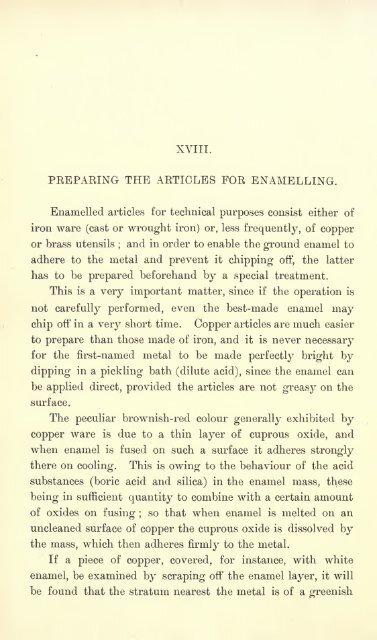Enamels and enamelling; an introduction to the preparation and ...
Enamels and enamelling; an introduction to the preparation and ...
Enamels and enamelling; an introduction to the preparation and ...
Create successful ePaper yourself
Turn your PDF publications into a flip-book with our unique Google optimized e-Paper software.
XVIII.<br />
PEEPAEING THE AETICLES FOE ENAMELLING.<br />
Enamelled articles for technical purposes consist ei<strong>the</strong>r of<br />
iron ware (cast or wrought iron) or, less frequently, of copper<br />
or brass utensils ;<br />
<strong><strong>an</strong>d</strong> in order <strong>to</strong> enable <strong>the</strong> ground enamel <strong>to</strong><br />
adhere <strong>to</strong> <strong>the</strong> metal <strong><strong>an</strong>d</strong> prevent it chipping off, <strong>the</strong> latter<br />
has <strong>to</strong> be prepared beforeh<strong><strong>an</strong>d</strong> by a special treatment.<br />
This is a very import<strong>an</strong>t matter, since if <strong>the</strong> operation is<br />
not carefully performed, even <strong>the</strong> best-made enamel may<br />
chip off in a very short time. Copper articles are much easier<br />
<strong>to</strong> prepare th<strong>an</strong> those made of iron, <strong><strong>an</strong>d</strong> it is never necessary<br />
for <strong>the</strong> first-named metal <strong>to</strong> be made perfectly bright by<br />
dipping in a pickling bath (dilute acid), since <strong>the</strong> enamel c<strong>an</strong><br />
be applied direct, provided <strong>the</strong> articles are not greasy on <strong>the</strong><br />
surface.<br />
The peculiar brownish-red colour generally exhibited by<br />
copper ware is due <strong>to</strong> a thin layer of cuprous oxide, <strong><strong>an</strong>d</strong><br />
when enamel is fused on such a surface it adheres strongly<br />
<strong>the</strong>re on cooling. This is owing <strong>to</strong> <strong>the</strong> behaviour of <strong>the</strong> acid<br />
subst<strong>an</strong>ces (boric acid <strong><strong>an</strong>d</strong> silica) in <strong>the</strong> enamel mass, <strong>the</strong>se<br />
being in sufficient qu<strong>an</strong>tity <strong>to</strong> combine with a certain amount<br />
of oxides on fusing ; so that when enamel is melted on <strong>an</strong><br />
uncle<strong>an</strong>ed surface of copper <strong>the</strong> cuprous oxide is dissolved by<br />
<strong>the</strong> mass, which <strong>the</strong>n adheres firmly <strong>to</strong> <strong>the</strong> metal.<br />
If a piece of copper, covered, for inst<strong>an</strong>ce, with white<br />
enamel, be examined by scraping off <strong>the</strong> enamel layer, it will<br />
be found that <strong>the</strong> stratum nearest <strong>the</strong> metal is of a greenish
















